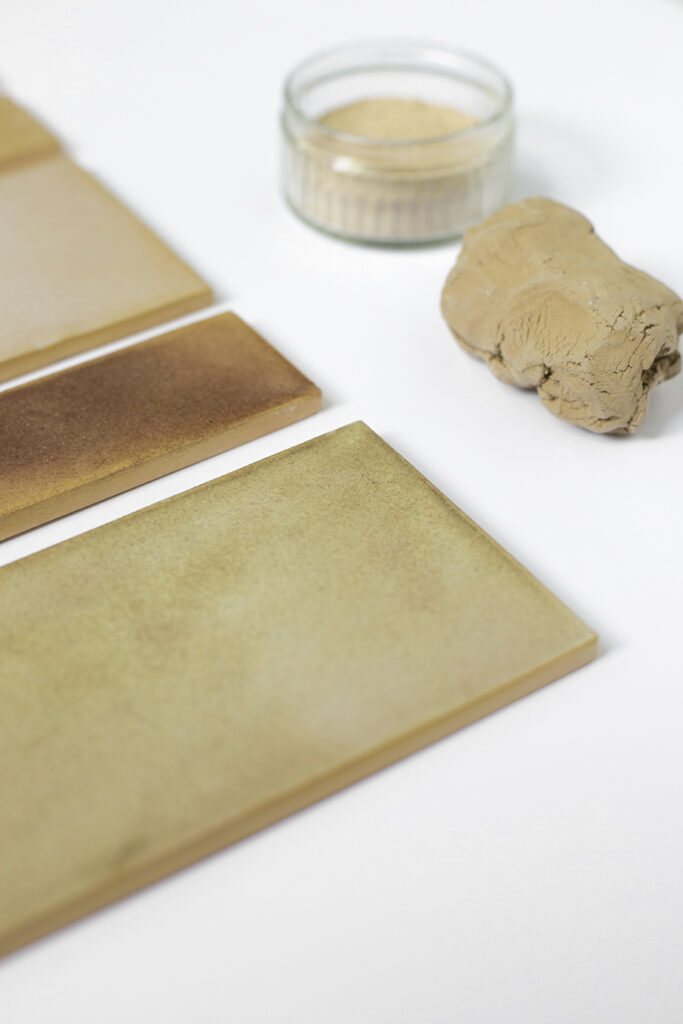
Terres émaillées
Recherche soutenue par Faire Paris, 2022
FR: Un des grands défis des chantiers franciliens concerne les terres d’excavation engendrées par les travaux de terrassements, de fondation ou souterrains. Généralement considérées comme déchets, ces matières sont majoritairement stockées ou enfouies. Cette recherche, menée grâce à FAIRE Paris, accélérateur de projet lancé par le Pavillon de l’Arsenal, explore un potentiel nouveau de remploi de ces terres pour la création de céramiques. L’ambition est tant de démontrer les capacités physiques de ces rebuts et que de valoriser leurs qualités esthétiques par la mise en valeur des couleurs du grand paris. Les pâtes céramiques et les émaux peuvent être entièrement constitués de matériaux excavés tels que l’argile, la marne, les limons des plateaux, les sables, le calcaire ou la craie.
Ce projet est réalisé en contact avec ECT, Cycle Terre, Placo, Grand Huit architectes, la Société du Grand Paris, la géologue Myriam Duc, la section céramique de l’école Duperré, ainsi que la manufacture Cerafrance.
EN: This project won the FAIRE Paris open call, and was granted fundings by the Pavillon de l’Arenal. In the Parisian region alone, more than 20 millions tons of excavated soil are extracted each year. Most of the excavated soil is sent to landfills. This soil is considered as waste even though it can be a resource. The current development plan to extend metro lines in Paris and the suburbs generates even more excavated soils. This research is about creating glazed ceramic tiles from that excavated soil and demolition waste. These excavated materials such as clay, marl, sand, limestone, as well as demolition waste can be reused to make ceramic objects, and /or glazes.



Limon des plateaux (loess)


Marne bleue d’Argenteuil (marl)


Argile brune (black clay)


Argile verte de Romainville (green clay)

Emaux de grès – Stoneware glazing
FR: Les émaux de grès sont 100% formulés à base de matériaux excavés ou de démolition. Certains carreaux de grès de réemploi, surplus de chantier, ont été ré-émaillés pour leur donner une nouvelle vie. Le processus de fabrication minimise également l’énergie de la cuisson en pratiquant par exemple la mono cuisson.
EN: Glazes for stoneware or porcelain can entirely be made with excavated materials, such as sand, marl and limestone. Some second-hand tiles were re-glazed to give them a new life.


Carreaux de faïence – Tiles made from excavated clay
FR: Les argiles présentes dans le bassin parisien peuvent être cuites comme de la faïence. La pâte céramique est entièrement constituée de matériaux excavés et de rebuts d’Ile-de-France. EN: These low firing tiles have a clay body entirely made with materials from Paris Region, including excavated clay, sand and smashed bricks.




Process








Terres émaillées
2022
FR: Un des grands défis des chantiers franciliens concerne les terres d’excavation engendrées par les travaux de terrassements, de fondation ou souterrains. Généralement considérées comme déchets, ces matières sont majoritairement stockées ou enfouies. Cette recherche, menée grâce à FAIRE Paris, accélérateur de projet lancé par le Pavillon de l’Arsenal, explore un potentiel nouveau de remploi de ces terres pour la création de céramiques. L’ambition est tant de démontrer les capacités physiques de ces rebuts et que de valoriser leurs qualités esthétiques par la mise en valeur des couleurs du Grand Paris. Les pâtes céramiques et les émaux peuvent être entièrement constitués de matériaux excavés tels que l’argile verte, la marne bleue, les limons des plateaux, les sables de Beauchamp, le calcaire ou la craie.
Ce projet est réalisé en contact avec ECT, Cycle Terre, Placo, Grand Huit architectes, la Société du Grand Paris, la géologue Myriam Duc, la section céramique de l’école Duperré, ainsi que la manufacture Cerafrance.
EN: This project won the FAIRE Paris open call, and was granted fundings by the Pavillon de l’Arenal. In the Parisian region alone, more than 20 millions tons of excavated soil are extracted each year. Most of the excavated soil is sent to landfills. This soil is considered as waste even though it can be a resource. The current development plan to extend metro lines in Paris and the suburbs generates even more excavated soils. This research is about creating glazed ceramic tiles from that excavated soil and demolition waste. These excavated materials such as clay, marl, sand, limestone, as well as demolition waste can be reused to make ceramic objects, and /or glazes.


Emaux de grès Stoneware glazing
Des émaux pour le grès peuvent être entièrement constitués de matériaux excavés tels que le sable, le calcaire ou la marne.



Carreaux en terre de chantier Tiles made from excavated clay
Les pâtes céramiques développées sont entièrement constituées d’argiles de chantier et de matériaux de rebuts.




